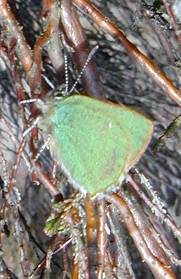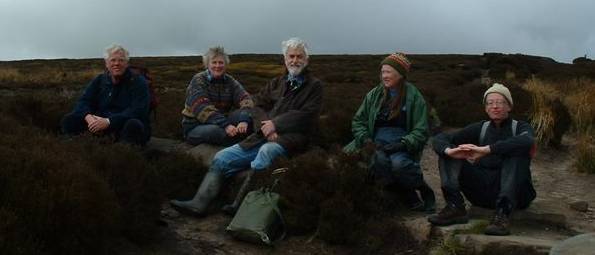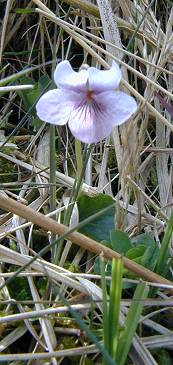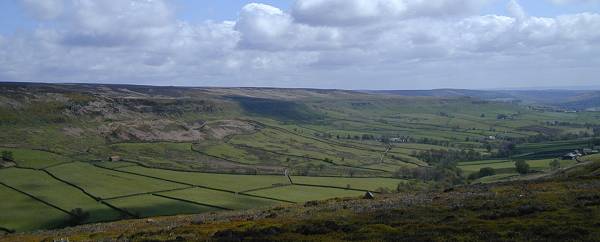Shunner Howe to Blakey, May 10th
led by Tom Denney; photos by Adrian Smith & Tom Denney
 Sadly this was a grey day with a perishing NE wind and occasional shafts of very cold rain – more like February than mid-May! However, half a dozen brave members met at Rosedale Abbey for this walk across the high moor. We drove up above High Hamer and set off westwards across the rather bleak high tops towards Loose Howe. Just after we started we noticed two or three green hairstreak butterflies in the heather (much less well camouflaged than they would have been with their wings open, showing the brown upper side – right). Much of our route followed the Lyke Wake Walk, marked out by boundary stones with white-painted tops. These stones had neatly carved letters, R on the Rosedale side and D on the other, presumably for Danby. This is a substantial stretch of wild, open moorland straddling the main north-south watershed, remote from the modern roads. We did however pass part of a stone built “trod” or causeway, and where this crossed the line of boundary stones there is a particularly fine stone marked “Causeway Stone” dated (I think) 1867 which appeared to be part of the same set as the R/D stones. Walking up here is quite challenging, with a good deal of leaping from one tussock to another across the expanse of peat bog.
Sadly this was a grey day with a perishing NE wind and occasional shafts of very cold rain – more like February than mid-May! However, half a dozen brave members met at Rosedale Abbey for this walk across the high moor. We drove up above High Hamer and set off westwards across the rather bleak high tops towards Loose Howe. Just after we started we noticed two or three green hairstreak butterflies in the heather (much less well camouflaged than they would have been with their wings open, showing the brown upper side – right). Much of our route followed the Lyke Wake Walk, marked out by boundary stones with white-painted tops. These stones had neatly carved letters, R on the Rosedale side and D on the other, presumably for Danby. This is a substantial stretch of wild, open moorland straddling the main north-south watershed, remote from the modern roads. We did however pass part of a stone built “trod” or causeway, and where this crossed the line of boundary stones there is a particularly fine stone marked “Causeway Stone” dated (I think) 1867 which appeared to be part of the same set as the R/D stones. Walking up here is quite challenging, with a good deal of leaping from one tussock to another across the expanse of peat bog.

The intrepid few sitting on the causeway... photo: Tom Denney
From a botanical point of view this was not a particularly interesting walk, partly because we were too early for most species to be in bloom, and partly because there are not all that many different species growing in such exposed conditions anyway. There were several different lichens, including one with small red fruiting bodies and one with little cups.
 One surprise was to find marsh violet actually in flower right up on the watershed, growing in one of the many bogs (left). There were at least three different sedges in flower together with a spike-rush and what I think was harestail cotton-grass but I am afraid I could not identify them. My excuse is that it was too cold to get down on my knees and examine them in detail with a lens; the truth is that I find sedges almost impossible to id!
One surprise was to find marsh violet actually in flower right up on the watershed, growing in one of the many bogs (left). There were at least three different sedges in flower together with a spike-rush and what I think was harestail cotton-grass but I am afraid I could not identify them. My excuse is that it was too cold to get down on my knees and examine them in detail with a lens; the truth is that I find sedges almost impossible to id!
There were not many birds in evidence, but we did hear the plaintive note of golden plovers, bubbling curlews and calling peewits (which we also saw), along with numerous meadow pipits and red grouse, and some gulls flying over. Just as we approached Loose Howe (at 1419') we got a magnificent view of a male golden plover, who was clearly trying to lead us away from his nest. In a welcome shaft of sunshine one could really see where the name “golden” plover came from: he was beautiful with his mottled gold-and-black back and coal black underside rimmed with white. Tom told us of the interesting finds when Loose Howe was excavated, to reveal a probable Bronze Age burial of a man in a boat (an oak dug-out). This was an interesting reminder that in prehistoric times the moors were in fact covered in woodland – indeed it is likely that the heather moorland is only maintained even now by grazing, Intriguingly, I did see a couple of small rowans and one seedling scots pine amongst the heather. I suspect that if these trees can survive until they are about three years old they are then too tough for the sheep to destroy, and if left will survive. As we were sitting on the howe we had a fine view of a single wheatear which Tom explained was a migrating male of the northern or Greenland form.
We then dropped down, crossed the road, and joined the line of the old mineral railway used to transport the ironstone when the Rosedale mines were working in the early 20th century. As we walked around the head of the dale we saw or heard other birds including woodland species like the willow warbler and robin. Sadly we did not see either ring ousels or whinchats, both of which might have been expected on this walk. We followed the railway round to the Lion Inn where we ended the walk and met up with Janet who did a sterling job as the ‘taxi’. As you can see from the picture below the weather improved considerably as we approached Blakey Rigg. We thanked Tom for leading the walk, then the party split up, some members electing to walk back to Rosedale Abbey, others to have a welcome drink and lunch at the pub before taking the easy option and getting a lift back down.

View across Rosedale from Blakey side
Species lists
Birds
Thanks to Tom Denney for this list:
Wheatear*; red grouse; curlew; golden plover; lapwing; meadow pipit; black-headed gull; common gull; lesser black-backed gull; swallow; swift; willow warbler; robin, whinchat (possibly, heard singing).
*the wheatear would be the northern race Oenanthe leucorhoa on its way to Iceland/Greenland. Our wheatear Oenanthe oenathe arrives in late March and would have settled down to breed by now. “I did expect we would see ring ousel and whinchat (the singing was a possible) but the cold weather and the wind did not make for good birding!” [It must be noted that Janet saw a male merlin while driving back down from High Hamer!]
Back to the top
Mammals
Rabbit, hare (one individual seen running across the open moor).
Plants
This list excludes most sedges and grasses.
| Bellis perennis |
Daisy |
| Betula pendula |
Birch, silver |
| Blechnum spicant |
Hard Fern |
| Callitriche agg. |
Starwort |
| Calluna vulgaris |
Heather |
| Cardamine pratensis |
Cuckoo flower or Milkmaid |
| Cirsium palustre |
Thistle, marsh |
| Crataegus monogyna |
Hawthorn |
| Digitalis purpurea |
Foxglove |
| Empetrum nigrum |
Crowberry |
| Pilosella officinarum |
Hawkweed, mouse eared |
| Juncus effusus |
Soft Rush |
| Larix sp. (L. decidua) |
Larch |
| Luzula multiflora |
Woodrush, heath |
| Molinia caerulea |
Purple Moor Grass |
| Montia fontanum |
Blinks |
| Pinus sylvestris |
Scots pine |
| Pteridium aquilinum |
Bracken |
| Rumex acetosella |
Sorrel, sheeps |
| Salix caprea |
Willow, goat |
| Sorbus aucuparia |
Rowan |
| Taraxacum sp. |
Dandelion |
| Teucrium scorodonia |
Wood sage |
| Trifolium repens |
White clover |
| Urtica dioica |
Nettle |
| Vaccinium myrtillus |
Bilberry |
| Veronica chamaedrys |
Speedwell, germander |
| Viola palustris |
Violet, marsh |
28 spp.
(several of them on the grass of the roadside verge).
© Ryedale Natural History Society 2005
Photos © Adrian Smith and Tom Denney 2005 |
Gill Smith, May 2005 |
Back to the Index page
 Sadly this was a grey day with a perishing NE wind and occasional shafts of very cold rain – more like February than mid-May! However, half a dozen brave members met at Rosedale Abbey for this walk across the high moor. We drove up above High Hamer and set off westwards across the rather bleak high tops towards Loose Howe. Just after we started we noticed two or three green hairstreak butterflies in the heather (much less well camouflaged than they would have been with their wings open, showing the brown upper side – right). Much of our route followed the Lyke Wake Walk, marked out by boundary stones with white-painted tops. These stones had neatly carved letters, R on the Rosedale side and D on the other, presumably for Danby. This is a substantial stretch of wild, open moorland straddling the main north-south watershed, remote from the modern roads. We did however pass part of a stone built “trod” or causeway, and where this crossed the line of boundary stones there is a particularly fine stone marked “Causeway Stone” dated (I think) 1867 which appeared to be part of the same set as the R/D stones. Walking up here is quite challenging, with a good deal of leaping from one tussock to another across the expanse of peat bog.
Sadly this was a grey day with a perishing NE wind and occasional shafts of very cold rain – more like February than mid-May! However, half a dozen brave members met at Rosedale Abbey for this walk across the high moor. We drove up above High Hamer and set off westwards across the rather bleak high tops towards Loose Howe. Just after we started we noticed two or three green hairstreak butterflies in the heather (much less well camouflaged than they would have been with their wings open, showing the brown upper side – right). Much of our route followed the Lyke Wake Walk, marked out by boundary stones with white-painted tops. These stones had neatly carved letters, R on the Rosedale side and D on the other, presumably for Danby. This is a substantial stretch of wild, open moorland straddling the main north-south watershed, remote from the modern roads. We did however pass part of a stone built “trod” or causeway, and where this crossed the line of boundary stones there is a particularly fine stone marked “Causeway Stone” dated (I think) 1867 which appeared to be part of the same set as the R/D stones. Walking up here is quite challenging, with a good deal of leaping from one tussock to another across the expanse of peat bog.
 One surprise was to find marsh violet actually in flower right up on the watershed, growing in one of the many bogs (left). There were at least three different sedges in flower together with a spike-rush and what I think was harestail cotton-grass but I am afraid I could not identify them. My excuse is that it was too cold to get down on my knees and examine them in detail with a lens; the truth is that I find sedges almost impossible to id!
One surprise was to find marsh violet actually in flower right up on the watershed, growing in one of the many bogs (left). There were at least three different sedges in flower together with a spike-rush and what I think was harestail cotton-grass but I am afraid I could not identify them. My excuse is that it was too cold to get down on my knees and examine them in detail with a lens; the truth is that I find sedges almost impossible to id!